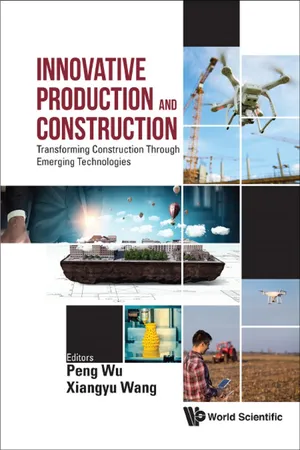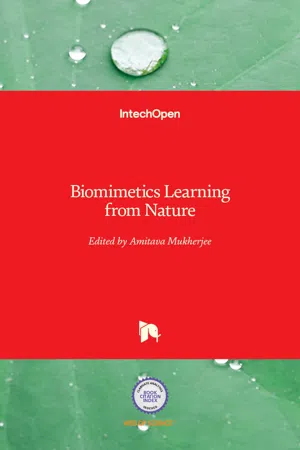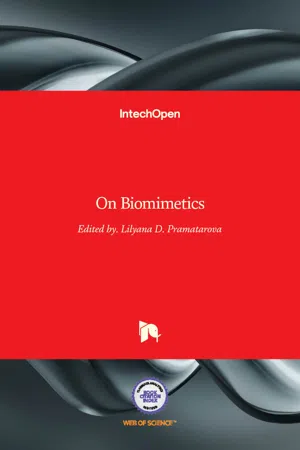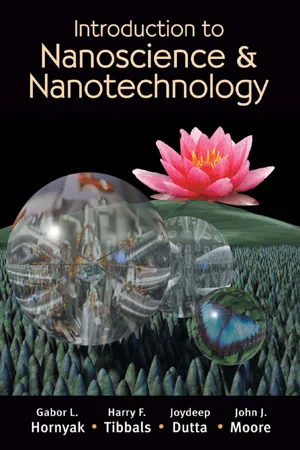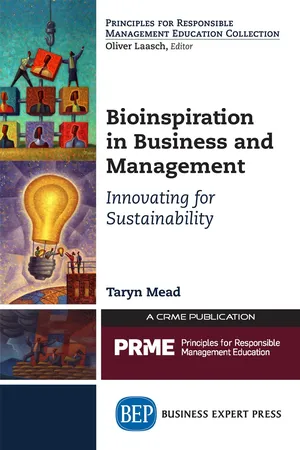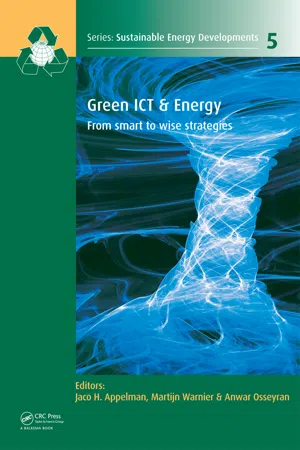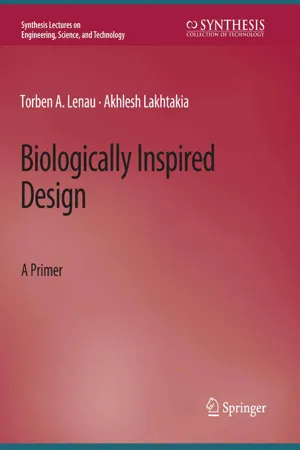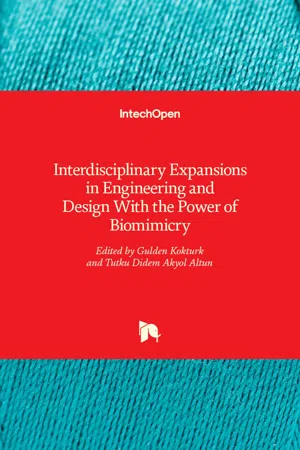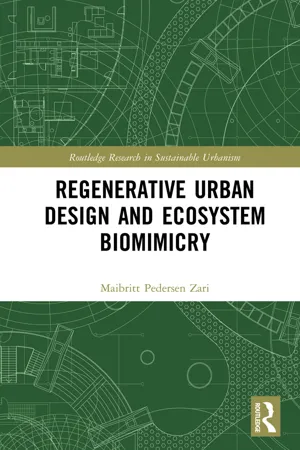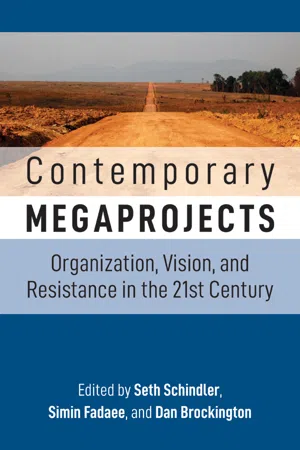Geography
Biomimetics
Biomimetics is the study of nature's designs, processes, and systems to inspire and inform human innovation. It involves mimicking biological strategies and structures to develop new technologies and solutions. In geography, biomimetics can be applied to sustainable design, urban planning, and environmental management, drawing on nature's efficiency and resilience to address human challenges.
Written by Perlego with AI-assistance
Related key terms
1 of 5
12 Key excerpts on "Biomimetics"
- eBook - ePub
Innovative Production and Construction
Transforming Construction through Emerging Technologies
- Peng Wu, Xiangyu Wang(Authors)
- 2019(Publication Date)
- WSPC(Publisher)
Biomimicry proponents believed that the industry needs to study the highly successful Research and Development (R&D)) lab that has been operational on earth for over 3.8 billion years in which 10–30 million species have learned to do everything humans want to do, without polluting the environment or mortgaging the common future of generations to come (Strategic Direction, 2008). It is believed that innovations, ideas and solutions inspired by nature are now the panacea to the challenges facing humanity. However, biomimicry encourages the teaming up of biologists with designers and professionals from various fields (industrial design, medical science, materials science, architecture and interior design) to study processes and materials in nature, and then apply those natural models to the man-made or built environment. Rather than utilizing nature for human advantage and use, biomimicry focuses on the identification and integration of ideas that are predominantly sustainable and amenable to earth’s capacity (Goss, 2009).4.Biomimicry Approaches/Design Strategies
These are approaches that help to redefine the levels of biomimicry and its potential as a tool for sustainability. They offer unique focal points and step-by-step paths under the larger umbrella of biomimicry (Niewiarowski and Paige, 2011) to provide methodologies through which biomimicry can be incorporated into various disciplines in order to arrive at a sustainable, effective and efficient solution. They are also referred to as the biomimicry thinking process which is a multiplex procedure combining design and systemic thinking with life principles (sustainability). They furnish the context to what, why, how and why biomimicry application fits into any discipline or design scale (Planet, 2016). Biomimicry proponents believe that strict adherence to the steps constituting the approaches will result in sustainable outcomes, either in tackling human challenges or in innovative design solutions.4.1.Biomimicry problem-based approach
The problem-based approach is also known as design looking to biology approach (Zari, 2007), problem-driven biologically inspired approach (Helms et al., 2009), top-down approach (Knippers, 2009; El-Zeiny, 2012), design-to-biology approach (Pandremenos et al., 2012), problem-to-solution approach (Buck, 2015). This approach entails defining a challenge by understanding and conceptualizing the processes and structures exhibited by natural organisms or ecosystems in resolving similar problems (Gamage and Hyde, 2012). Here, nature is looked at and turned to for solutions by first identifying the problems and then pairing such problems with organisms in nature that have resolved similar problems. In this approach, natural models are emulated to proffer solutions to a specific challenge (Pandremenos et al - eBook - PDF
Biomimetics
Learning from Nature
- Amitava Mukherjee(Author)
- 2010(Publication Date)
- IntechOpen(Publisher)
Several researchers were aware of this trend in the early 20th century (Schmitt 1969; Nachtigall 1989), but it was not until later that century that the formalized field of Biomimetics or Biomimicry came about. Biomimetics is devoted to studying nature’s best ideas to solve human problems through mimicry of the natural designs and processes (Benyus 1997). It is evident that mimicking biological designs or using them for inspiration leads to leaps in innovation (e.g., Flapping wing micro air vehicles, self-cooling buildings, self-cleaning glass, antibiotics that repel bacteria without creating resistance). This research focuses on making the novel designs of the natural world accessible to engineering designers through functionally representing biological systems with systematic design techniques. Functional models are the chosen method of representation, which provide a designer a system level abstraction, core functionality and individual functionalities present within the biological system. Therefore, the functional models translate the natural designs into an engineering context, which is useful for the conceptualization of biology inspired engineering designs. The biological system 5 Biomimetics, Learning from Nature 94 information is presented to engineering designers with varying biological knowledge, but a common understanding of engineering design methods. This chapter will demonstrate that creative and novel engineering designs result from mimicking what is found in the natural world. Although most biology inspired designs, as mentioned previously, are mechanical, structural or material, this research focuses on how biological organisms sense external stimuli for the use of novel sensor conceptualization. Sequences of chemical reactions and cellular signals during natural sensing are investigated and ported over to the engineering domain using the Functional Basis lexicon (Hirtz et al. 2002) and functional models. - eBook - PDF
- Assoc. Lilyana D. Pramatarova(Author)
- 2011(Publication Date)
- IntechOpen(Publisher)
Part 7 Application of Biomimetic Materials 27 Biomimicry of Termite Social Cohesion and Design to Inspire and Create Sustainable Systems J.R.J. French 1 and B.M. Ahmed (Shiday) 2 1 University of the Sunshine Coast, Faculty of Science, Health and Education, Maroochydore, 2 The University of Melbourne, Department of Forest and Ecosystem Science, Richmond, Australia 1. Introduction Biomimicry (from bios, meaning life, and mimesis, meaning to imitate) is a new discipline that studies nature's best ideas and then imitates these designs and processes to solve human problems. The core idea of biomimicry as enunciated by the Biomimicry Institute (Anon 2008) is that nature, imaginative by necessity, has already solved many of the problems we are grappling with. Margulis (1998) considers that the major kinds of life on Earth are bacteria, protoctists, fungi, animals and plants. All have become the consummate survivors. They have found what works, what is appropriate, and most important, what lasts here on Earth. This is the real news of biomimicry: After 4 billion years of research and development, failures are fossils, and what surrounds us is the secret to survival. Termites have been experimenting for over 300 million years on our symbiotic planet and their current abundance and distribution attests to their co-evolutionary success. If we want to consciously emulate nature's genius, we need to look at nature differently. In biomimicry, we look at nature as model, measure, and mentor (Anon 2008; & 2011). Nature as model: Biomimicry is a new science that studies nature’s models and then emulates these forms, process, systems, and strategies to solve human problems – sustainably. Nature as measure: Biomimicry uses an ecological standard to judge the sustainability of our innovations. After nearly 4 billion years of evolution, nature has learned what works and what lasts. Nature as mentor: Biomimicry is a new way of viewing and valuing nature. - Gabor L. Hornyak, H.F. Tibbals, Joydeep Dutta, John J. Moore(Authors)
- 2008(Publication Date)
- CRC Press(Publisher)
In recent times biomimicry has been used to describe a general approach to engineering and economics with emphasis on sustainability and environmental compatibility [3]. According to the Biomimicry Institute [42] Biomimicry (from the Greek bios, “life” + mimesis, “imitate”) is a new science that studies nature’s best ideas and then imitates these designs and processes to solve human problems. Biognosis is a related term, used to refer to systems of knowledge and practice based on nature and natural principles. Biomimetic Nanotechnology: An Interdisciplinary Field. Biomimetics and nan-otechnology are both interdisciplinary, new, and rapidly growing. For the pur-pose of this chapter, we define biomimetic nanotechnology as the design of materials and devices based on nanoscale biological structure and function. The purpose of Biomimetics is to pattern useful materials and devices after biological blueprints. As stated by Claus Mattheck at the Forschungszentrum Karlsruhe in Germany [43]: Modern Biomimetics is a systematic approach for researchers who know that new developments and insights can only be achieved in transdisciplinary col-laborations. If this is true for examples of co-working between physicists or chemists and engineers, why not networking with biologists? Table 26.1 summarizes the frequency of the bio-terms discussed above and their relation to nano. Nanotechnology (14,400,000) Nanoscience (810,000) Nanomaterials (1,350,000) Cumul. score Biotechnology 520,000 215,000 466,000 4 (49,300,000) 2 1 1 Bioengineering 1,280,000 39,600 31,500 5 (3,330,000) 1 2 4 Biomimetics 310,000 14,100 140,000 10 (1,130,000) 3 5 2 Biophysics 203,000 38,500 139,000 11 (4,540,000) 4 3 3 Biomechanics 72,000 16,200 17,000 14 (3,370,000) 5 4 5 Bionics 21,000 2,400 3,300 18 (908,000) 6 6 6 T ABLE 26.1 Google Hits of Bio + Nano Overlap and Place- eBook - PDF
- Gabor L. Hornyak, John J. Moore, H.F. Tibbals, Joydeep Dutta(Authors)
- 2018(Publication Date)
- CRC Press(Publisher)
Before we explore biologically inspired nanotechnologies, we will give some definitions that clarify the background and aims of Biomimetics in general. 12.0.1 Biomimetics, Bioengineering, and Other Bioengineering Fields The use of biological models in other fields is described by many terms— Biomimetics, bionics, biomechanics, biophysics, bioengineering, etc., terms that F IG . 12.0 Photosynthesis is a splendid example of natural molecular nanomachinery from which valuable lessons for technology can be drawn. Biomimetics 523 we will define to avoid confusion. Historically many aspects of bio-inspired engineering and technology originated separately, but their overlap and convergence is being accelerated by nanotechnology. Biomimetics. Biomimetics (from the Greek bios meaning “life, course or way of living” + mimetikos “imitative”) has roots in the beginnings of civilization. Biomi-metics is science or technology that copies or imitates nature to find new methods and applications. The Encyclopedia of Biomaterials and Biomedical Engineering gives the following definition [15]. Biomimetics is the study of how Nature, building atom by atom, through eons of time, developed manufacturing methods, materials, structures, and intelligence. These studies are inspiring engineering and design of manmade miniature objects.… It is in the nanoworld that Nature is way ahead of human engineering as it has learned to work with much smaller, more versatile building blocks and master the self-assembly of those building blocks.… We believe that, just as in the macroworld, blindly mimicking Nature will be unproductive, but studying Nature and taking hints as to how to build nanostructures from the bottom-up … will be productive. The term Biomimetics was coined in the 1950s by the American engineer and biophysicist Otto Herbert Schmitt. - eBook - ePub
Bioinspiration in Business and Management
Innovating for Sustainability
- Taryn Mead(Author)
- 2017(Publication Date)
- Business Expert Press(Publisher)
However, while Benyus’s book popularized the word as it is known today—connecting learning from nature with sustainability—the predecessors of the concept date back much further. And while these distinctions may seem trivial for managerial needs, there are various schools of related thought that have practical implications for sustainability-oriented innovators. The following section is a brief overview of the history of biologically inspired design and innovation.Biomimetic Promise: The common belief that innovations that model natural systems will be inherently novel, better performing, and more sustainable because they are based on natural systems. This represents a naturalist fallacy because it implies that because something is natural, it is also good without further critical analysis.Learning from nature is obviously not a new practice. Indeed, our very survival and evolution as a species has been dependent on learning from nature. Many forms of traditional ecological knowledge are based in an intimate connection with natural systems. As an example, the Inuit people of northern North America took cues from polar bears about the appropriate depth, construction, and orientation of their igloo homes. Leonardo Da Vinci took cues from birds when developing his first flying machines (Romei 2008). Even today, the flipped-up tips of airplane wings owe their existence to an engineer’s careful observation of soaring birds.As a specific area of study, bioinspiration emerged when the related terms Biomimetics and bionics were first applied to formal research agendas in the mid-1900s. Otto Schmitt is credited with coining the term Biomimetics in approximately 1969, while Jack Steele coined the term bionics in 1958. The primary difference that divides these two camps from each other and from biomimicry is the legacy of their origins. While Benyus was a biologist with a strong sustainability message, Schmitt was applying the concept to biomedical applications and Steele was applying it to aerospace engineering. The common thread that links these terms together is the idea of learning from nature. All three terms share the common etymology of bios-, the Ancient Greek word meaning life. Biomimicry and Biomimetics share the word—mimesis, meaning to imitate and the -ic in bionic means like or in the manner of. In short, all three terms refer to the imitation of biological models for human design and innovation solutions. This application can be metaphorical or analogical (discussed further on page 22 - eBook - PDF
Green ICT & Energy
From Smart to Wise Strategies
- Jaco H. Appelman, Anwar Osseyran, Martijn Warnier(Authors)
- 2013(Publication Date)
- CRC Press(Publisher)
CHAPTER 10 Biomimicry: Design and innovation that help reach eco-effective solutions Saskia Muisenberg, Jaco Appelman & Dayna Baumeister 10.1 INTRODUCTION In our search to come to useful and practical notions to stimulate attention to eco-effectiveness this chapter will connect the core concepts of biomimicry, as we understand and practice it and link the core concepts to the subject of green(-ing) ICT by giving you examples from practice. This way we come closer to giving the concept of eco-effectiveness body and plausibility. This chapter sketches the beginning of a new field of inquiry where nature provides the yardstick for progress. As such much is left to your own imagination, creativity, and innovative potential. This chapter aims to introduce and inspire, it does not provide a strategy or innovation roadmap. After an explanation of the concept of biomimicry, the different degrees of greening with biomimicry, and a very condensed overview of life’s principles, the chapter ends with a presentation of cases where biomimicry was used in organizational development and manufacturing. We leave it to your imagination how you can apply it in your organization. 10.1.1 What is it? Biomimicry, from the Greek bios = life; mimesis = to imitate, seeks nature’s advice as a guiding framework for a transition towards sustainable living. Around the world, biomimics are consulting life and its graceful, amazing solutions to create new products, processes, and policies—new ways of living—that are well adapted to life on earth for years to come. They have learned to grow food like a prairie, adhere like a blue mussel, sequester carbon like a coral reef, create color like a peacock, and run a business like a redwood forest. Biomimicry offers a new way of looking based on what we can learn from our nature, not on what we can extract from it. This shift from learning about nature to learning from nature requires a new method of inquiry and a new set of lenses. - eBook - PDF
Biologically Inspired Design
A Primer
- Torben A. Lenau, Akhlesh Lakhtakia(Authors)
- 2022(Publication Date)
- Springer(Publisher)
7.7. DESIGN APPROACHES 85 The International Standards Organization defines biomimicry as “philosophy and inter- disciplinary design approaches taking nature as a model to meet the challenges of sustainable development (social, environmental, and economic)” [42]. A distinction has been made in Chap- ter 1 between biomimicry and engineered biomimicry, the former being contained in the latter. Whereas engineered biomimicry does not need to be focused on reaching for sustainabil- ity goals, the term biomimicry—often associated with the Biomimicry Institute, an American non-profit organization—is focused on using inspiration from the bioworld to design solutions that contribute to sustainable development. The Biomimicry Institute has a sister organization called Biomimicry 3.8 which is a con- sultancy working together with companies to solve design problems. One of the founding mem- bers of both organizations is Janine Benyus. The two organizations have developed a basic frame- work for design work [43] and the database Asknature [44] which allow searches for biological strategies to solve specific functional challenges. To support sustainable development, the orga- nizations have formulated the following six lessons from the bioworld: • evolve to survive, • adapt to changing conditions, • be locally attuned and responsive, • use life-friendly chemistry, • be resource efficient, and • integrate development with growth. Each lesson leads to specific guidelines, such as incorporate diversity and use low-energy pro- cesses, that are mainly concerned with the environmental part of sustainable development. These guidelines function in the same way as the criteria for evaluation of design proposals described in Chapter 2. When two proposed solutions are compared, the preferred one has to satisfy more guidelines in the best way. Thus, these guidelines are not absolute but indicate desirable out- comes. - Gulden Kokturk, Tutku Didem Akyol Altun, Gulden Kokturk, Tutku Didem Akyol Altun(Authors)
- 2018(Publication Date)
- IntechOpen(Publisher)
Chapter 4 Biomimetic Design for a Bioengineered World Irem Deniz and Tugba Keskin-Gundogdu Additional information is available at the end of the chapter http://dx.doi.org/10.5772/intechopen.72912 Abstract Biodesign can be explained as a method that includes various researches and applications related to taking inspiration from natural functions, systems, components, or processes in solving a problem. Accordingly, biodesign is commonly used in the design of artifi -cial devices, structures, and buildings in the field of bioengineering. The recent develop -ments in the field of biotechnology and bioengineering bring out various products that are designed in collaboration with different engineering disciplines. In this chapter, the possible use of bacteria, microalgae, and fungi for biomimetic design and the role of bio-mimicry for these designs will be briefly discussed. Keywords: bioengineering, biomimetic design, biodesign, microalgae, fungi, bacteria 1. Introduction Biodesign, in which living organisms can be used as a design input, is a study field that takes nature as an example and aims to make sustainable, functional, durable, and nonhealth threatening products. In literature, biodesign appears together with concepts such as biomi -metics, biomimicry, design inspired by nature and morphogenic design [1]. Bioengineering is the application of engineering’s analytical, mathematical, and result-oriented approaches to the world of biology, while traditional engineering approaches focus on just mathemati-cal and physical applications to solve the problems or produce a product; bioengineering uses all the information about life, human, and all living organisms. This area includes all the necessary sciences. Bioengineering deals not just with scientific knowledge but also with engineering approaches. In addition to this, biodesign is a methodological approach of new innovations inspired by nature or using the living organism itself to make life easier.- Maibritt Pedersen Zari(Author)
- 2018(Publication Date)
- Routledge(Publisher)
Table 2.1 ).Biomimicry is often described as a tool to increase the sustainability of human-designed products, materials and the built environment. It should be noted that a lot of biomimetic technologies or materials are not inherently more sustainable than conventional equivalents and may not have been initially developed with such goals in mind. Furthermore, many examples of technologies or strategies that have achieved high ecological performance have been developed outside of a biomimicry paradigm. Biomimicry is not the only plausible way forward in terms of increased environmental performance of the built environment or regenerative design, and should not be thought of as a ‘global panacea’ (Gebeshuber et al., 2009).Through this examination of existing biomimetic technologies, architecture and the literature in general, it is clear that markedly different approaches to biomimetic design have evolved and can have different outcomes in terms of overall sustainability. Commonly given examples of successful biomimicry are typically products or materials rather than buildings or building systems, and tend to mimic parts of single organisms. Mimicking organisms can produce innovations that address sustainability issues in some cases (Pedersen Zari, 2010), but without an understanding of the ecological context of these organisms, such innovations can easily become technological add-ons to conventional architecture and buildings can remain average in terms of overall sustainability performance over whole life cycles (Armstrong, 2009). Such solutions also miss an opportunity to examine the possibility of systemic change in the built environment and to re-evaluate the nature of the relationship between people, their built environment and the ecosystems they exist in.- eBook - PDF
- Anne George(Author)
- 2011(Publication Date)
- IntechOpen(Publisher)
1 A Cultural Perspective on Biomimetics Bernadette Bensaude-Vincent Université Paris 1Panthéon-Sorbonne/IUF France 1. Introduction Gecko’s feet, lotus leaves, blue butterfly wings, spider’s silk, fireflies, mother-of-pearl…. All these wonders of nature, which traditionally filled the pages of natural history magazines have attracted the attention of materials scientists over the past decades. They have often been presented as models to design and engineer optimal structures. And this renewed interest in natural systems has undoubtedly brought about innovating strategies in chemistry, materials science and nanotechnology. But what exactly does mimicking nature mean? Can we really transfer nature’s “technology” to human projects? Does talking about “nature’s technology” even make sense? The view of technology copying nature is as fascinating as it is deceiving. We all know that in aeronautics, repeated attempts to mimic birds’ flight have led to spectacular failures. Hence the basic principles of modern technology are anything but inspired by nature: The mechanical machines, metallic alloys, combustion engines, jet engines, direct synthesis of ammonia, etc… have no equivalent in nature. They proceed from the fundamental laws of physics, thermodynamics, and aerodynamics rather than from imitating nature. At the other end of the spectrum, we all know a few examples of successful inventions, such as the Velcro, which was inspired from cockleburs clinging to socks or dog’s fur after a hike in the hills. Yet failures to imitate nature by far outnumber the rare successful biomimetic inventions. (Vogel, 1998) Does this mean that biomimicry strategies are generally doomed to fail? This chapter will consider the current biomimetic trends from a broad historical perspective. - eBook - PDF
Contemporary Megaprojects
Organization, Vision, and Resistance in the 21st Century
- Seth Schindler, Simin Fadaee, Dan Brockington(Authors)
- 2021(Publication Date)
- Berghahn Books(Publisher)
The author says material development seems to be the largest area of biomimicry research, accounting for approximately 50 percent of all reviewed references, and this research has yielded innovations across a range of fields including optical materials, medicine, agriculture, textiles, and coating materials. The second-largest 38 n Contemporary Megaprojects area of biomimicry application, according to her findings, is animal locomotion models: “Insights into the general principles that underlie movement, the mechanisms and struc-tures of muscular and skeletal systems provide insights that can be applied to increase the efficiency of moving vehicles, especially in robotics, or help to inspire entirely new modes of transport” (2014: 1499). Deconstructing Biomimicry The body of literature that specifically engages biomimicry from a critical humanities and social science perspective is more nascent but is already characterized by certain discernible trends. For example, much of it focuses on the militarization of the biological life aspect of biomimicry (Johnson 2010; Zerner 2012), which is unsurprising, given the somewhat occluded but highly relevant history of biomimicry as a research megaproject within DARPA. In response, Charles Zerner develops the concept of “stealth nature” to analyze DARPA projects involving Biomimetics 12 as a part of the militarized deployment of nature that include vivisystems (e.g., using bees or moths for environmental tracking) and hybrid biosystems designed to create animal-robot cyborgs for surveillance purposes. Biomimetics in this trifecta are the “mechanical devices that mimic the abilities and struc-tures of living beings, particularly insects (Masco 2004: 537, quoted in Zerner 2010: 297). Zerner contextualizes biomimicry within a long history of intellectual enchantment with biological structures and processes, and, in discussing the work of the aforementioned champion of biomimicry, he states: Bar-Cohen’s reverence .
Index pages curate the most relevant extracts from our library of academic textbooks. They’ve been created using an in-house natural language model (NLM), each adding context and meaning to key research topics.
